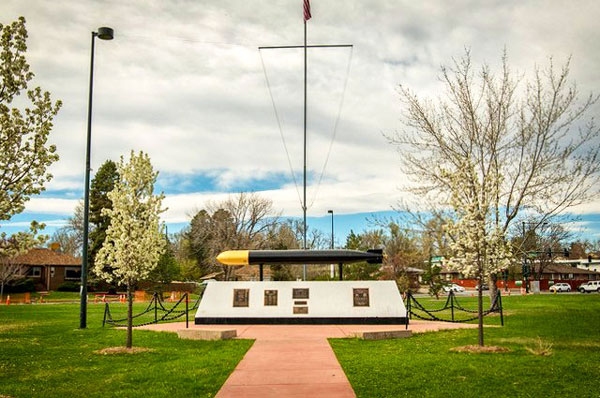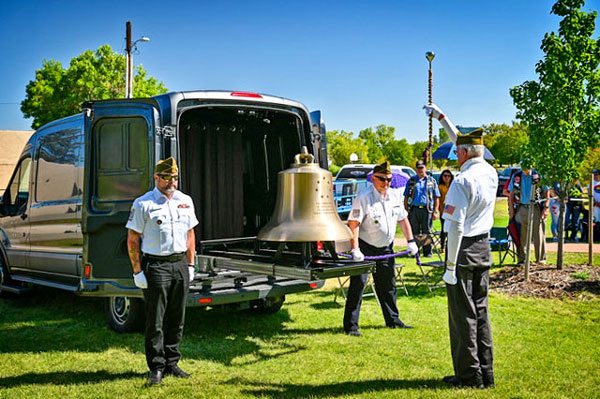Run silent, run deep: A Colorado memorial
By Joe Gschwendtner; courtesy photos

Pictured above is the U.S.S. Grayling (SS-209), a Sturgeon-clad attack submarine is located in Sloan’s Lake Park in Denver. The memorial honors the U.S.S. Grayling and all U.S. submarines and crew who gave their lives in service during WWII and are now on eternal patrol. (Inset) On September 25, the Rocky Mountain Submarine Veterans honor the U.S.S. Grayling with a “Tolling of the Boats” ceremony. During the ceremony the name of every boat lost during WWII was read out loud and a bell tolled for each.

November 11 is Veterans Day, one day out of the year that honors all those who have served in the U.S. military.
The U.S.S. Grayling Memorial, located at Sloan’s Lake in Denver, honors a World War II submarine lost in action in the waters of Manila Bay. Her monument represents all WWII submarines that did not return.
Only 2% of naval personnel in WWII, the submarine force inflicted 55% of Japan’s maritime losses. U.S. casualties included 52 submarines and the 3,400 crew members on board. One in five submariners would not return home.
In Groton, Connecticut, a group of WWII veterans decided that they needed to band together to ensure that those who died (seen as being on eternal patrol) would never be forgotten and founded the United States Submarine Veterans, Inc. (USSVI) in 1963. There were further goals, but the effusive camaraderie unique to the force bubbled up, insisting that those lives be honored in perpetuity.
Colorado Base Commander Bruce Marsden, a Vietnam-era submariner and president of the Colorado chapter of the USSVI, shared why the underwater service is unique. “Crew members serve long hours and days under challenging conditions in cramped quarters,” he said. “In World War II boats, both physical and psychological privacy did not exist. This demanded a mutual respect for all. Crew members have an unspoken tradition of taking care of each other. All are cross-trained in shipboard operations; some can perform every critical task.”
The submarine force has a continuous improvement mentality. Due to sailors’ utter isolation, the situation demands they resolve tactical, mechanical and weapons issues with virtually no outside help. This tradition has played no small part in the development of advanced sonar ranging, cold war tactics, and the epic and successful marriage of nuclear energy and underwater propulsion.
Just as Navy SEALs proudly wear tridents on their uniforms, so does the silent service display a dolphin on their individual uniforms, earned only after a rigorous program aboard their boat.
Since 52 submarines were lost in WWII and there are 50 states, there is a memorial for each – one in every state and two each in California and New York. Colorado honors the U.S.S. Grayling. Every year a “Tolling of the Boats” ceremony is held at the memorial where the names of every boat lost are read out loud and a bell is tolled for each.
Numbered SS-209, the Grayling’s keel was laid in at the Portsmouth, New Hampshire, Naval Shipyard. Commissioned in March 1941, she displaced 1,475 tons, was longer than a football field, and was 27 feet wide at her center. A diesel-powered vessel, she had 10 torpedo tubes and carried 24 torpedoes. Grayling was rushed to Hawaii after the attack on Pearl Harbor in December that same year. She was lethal in sinking Japanese cargo ships – joining the Battle of Midway, and delivering supplies to the Philippine resistance.
Based in Fremantle, Australia, she sank her last ship on August 27, 1943 in Philippine shipping lanes. Headquarters communications with the Grayling were lost after September 9, 1943. Her loss took 76 crew members to the bottom of the sea.
For those so inclined, a trip to Sloan’s Lake would be a meaningful event of silent gratitude this Veterans Day. Bring the kids so that they might learn how our freedoms were defended.